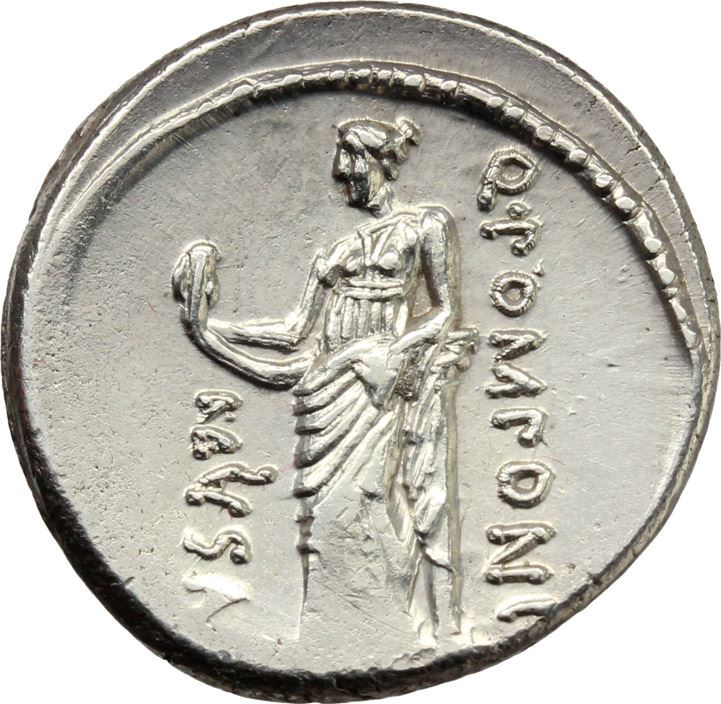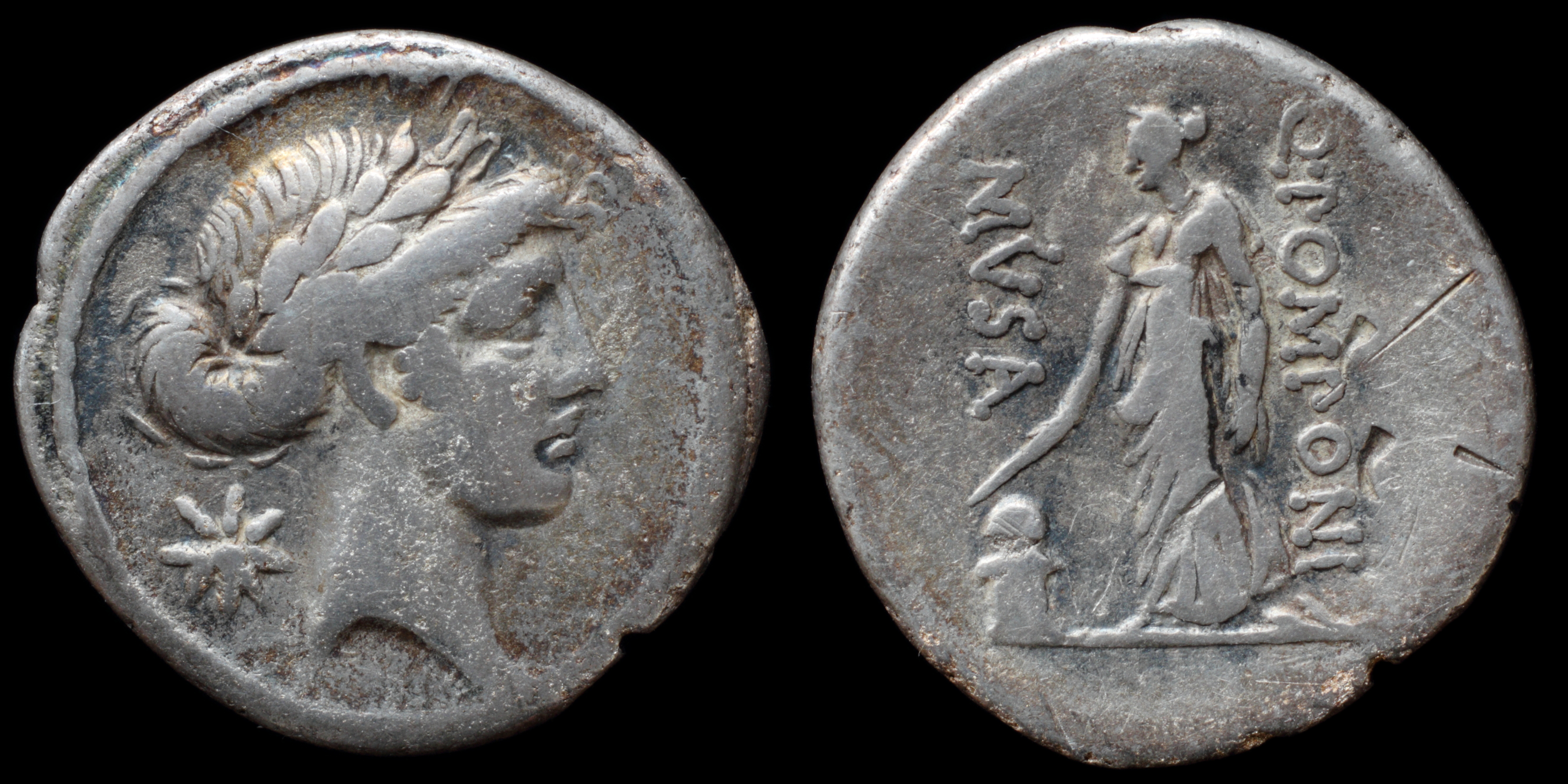Quintus Pomponius Musa was a magistrate, moneyer and banker during the Republican Period in Rome, around 66 BC.
Musa created ten coin designs: one design for each of the nine Muses, a play on Musa's name; and one coin featuring the image of Hercules with the inscription HERCULES MUSARUM (Hercules of the Muses). All ten designs depict the specific muse on the reverse, while featuring the image of Apollo on the obverse; Apollo presided over the Muses.
When Hercules is represented, he is called Hercules Musarum, or Musageta, that is, "The leader of the Muses." He was known by this name in Greece, and later in Rome, when his statue and those of the nine Muses were brought from Greece, and the temple erected there for their reception.
Musa created ten coin designs: one design for each of the nine Muses, a play on Musa's name; and one coin featuring the image of Hercules with the inscription HERCULES MUSARUM (Hercules of the Muses). All ten designs depict the specific muse on the reverse, while featuring the image of Apollo on the obverse; Apollo presided over the Muses.
When Hercules is represented, he is called Hercules Musarum, or Musageta, that is, "The leader of the Muses." He was known by this name in Greece, and later in Rome, when his statue and those of the nine Muses were brought from Greece, and the temple erected there for their reception.


Obverse: Laureate bust of Apollo (or Erato?) facing right with hair rolled back and in loose locks over the forehead, flower or rosette before ear and a flower on stalk (or a compound plectrum?) to left, possibly a lily.
Reverse: Erato, the Muse of Erotic Poetry, standing slightly right, habited in the stola — over which is the palla, — holding a kithara, and playing upon it with a simple plectrum held at her side; Q•POMPONI to left; MVSA to right.
Diameter:
20 mm
Die Orientation: -
Weight: 3.98 g
Die Orientation: -
Weight: 3.98 g
"Quintus Pomponius Musa, otherwise unknown, minted a series of coins in 56 BC. Each of Musa’s reverses features one of the nine muses, each identifiable by her attributes. In the field behind a bust of Apollo, each obverse type bears a control mark which appears to correspond to the attribute possessed by the muse on the reverse. Apart from the clear reference to the moneyers name it is believed another inspiration source was a temple of Hercules and the Muses, erected by M. Fulvius Nobilior after his capture of Ambracia in 189 BC. Fulvius is said to have done this because he learned in Greece that Hercules was a musagetes. In this temple Fulvius set up a copy of the Fasti with notes, probably the first of this kind and also statues from Ambracia of the nine Muses by an unknown artist, and that of Hercules playing the lyre.
The Muses are the inspirational goddesses of literature, science, and the arts in Greek mythology. They were considered the source of the knowledge embodied in the poetry, lyric songs, and myths that were related orally for centuries in these ancient cultures. They were later adopted by the Romans as a part of their pantheon. According to Hesiod's Theogony from the seventh century BC, they were daughters of Zeus, king of the gods, and Mnemosyne, Titan goddess of memory. For Alcman and Mimnermus, they were even more primordial, springing from the early deities Ouranos and Gaia. Gaia is Mother Earth, an early mother goddess who was worshipped at Delphi from prehistoric times, long before the site was rededicated to Apollo, possibly indicating a transfer to association with him after that time.
Sometimes the Muses are referred to as water nymphs, associated with the springs of Helicon and with Pieris. It was said that the winged horse Pegasus touched his hooves to the ground on Helicon, causing four sacred springs to burst forth, from which the Muses were born. Athena later tamed the horse and presented him to the Muses.
Classical writers set Apollo as their leader. In one myth, the Muses judged a contest between Apollo and Marsyas. They also gathered the pieces of the dead body of Orpheus, son of Calliope, and buried them in Leivithra. In a later myth, Thamyris challenged them to a singing contest. They won and punished Thamyris by blinding him and robbing him of his singing ability. The earliest known records of the Nine Muses are from Boeotia, the homeland of Hesiod.
It was not until Hellenistic times that the following systematic set of functions was assigned to them, and even then there was some variation in both their names and their attributes: Calliope (epic poetry), Clio (history), Euterpe (flutes and lyric poetry), Thalia (comedy and pastoral poetry), Melpomene (tragedy), Terpsichore (dance), Erato (erotic/love poetry), Polyhymnia (sacred poetry), Urania (astronomy).
Erato was one of the nine Muses. In the Classical era, when the Muses were assigned specific literary and artistic spheres, Erato was named Muse of erotic poetry and mime, and represented with a kithara. Her name means "lovely" or "desired" from the Greek word eratos."
Provenance: Purchased from Moruzzi Numismatica (25 April 2018).
The Muses are the inspirational goddesses of literature, science, and the arts in Greek mythology. They were considered the source of the knowledge embodied in the poetry, lyric songs, and myths that were related orally for centuries in these ancient cultures. They were later adopted by the Romans as a part of their pantheon. According to Hesiod's Theogony from the seventh century BC, they were daughters of Zeus, king of the gods, and Mnemosyne, Titan goddess of memory. For Alcman and Mimnermus, they were even more primordial, springing from the early deities Ouranos and Gaia. Gaia is Mother Earth, an early mother goddess who was worshipped at Delphi from prehistoric times, long before the site was rededicated to Apollo, possibly indicating a transfer to association with him after that time.
Sometimes the Muses are referred to as water nymphs, associated with the springs of Helicon and with Pieris. It was said that the winged horse Pegasus touched his hooves to the ground on Helicon, causing four sacred springs to burst forth, from which the Muses were born. Athena later tamed the horse and presented him to the Muses.
Classical writers set Apollo as their leader. In one myth, the Muses judged a contest between Apollo and Marsyas. They also gathered the pieces of the dead body of Orpheus, son of Calliope, and buried them in Leivithra. In a later myth, Thamyris challenged them to a singing contest. They won and punished Thamyris by blinding him and robbing him of his singing ability. The earliest known records of the Nine Muses are from Boeotia, the homeland of Hesiod.
It was not until Hellenistic times that the following systematic set of functions was assigned to them, and even then there was some variation in both their names and their attributes: Calliope (epic poetry), Clio (history), Euterpe (flutes and lyric poetry), Thalia (comedy and pastoral poetry), Melpomene (tragedy), Terpsichore (dance), Erato (erotic/love poetry), Polyhymnia (sacred poetry), Urania (astronomy).
Erato was one of the nine Muses. In the Classical era, when the Muses were assigned specific literary and artistic spheres, Erato was named Muse of erotic poetry and mime, and represented with a kithara. Her name means "lovely" or "desired" from the Greek word eratos."
Provenance: Purchased from Moruzzi Numismatica (25 April 2018).
Crawford 410/7b corr. (rev. type)

Obverse: Laureate head of Apollo (or Urania?) facing right with hair rolled back and in loose locks over the forehead, flower or rosette before ear and a star of eight rays to left.
Reverse: Urania, the Muse of Astronomy, wearing long flowing tunic and peplum, standing left, touching with wand held in right hand a globe set on base; Q • POMPONI downward to right, MVSA downward to left.
Diameter:
4.06 mm
Die Orientation: -
Weight: 18.5 g
Die Orientation: -
Weight: 18.5 g
Provenance: Naville Numismatics Auction 46, (27 January 2019) lot 371. Ex Varesi sale 28, (1998) lot 182.
Crawford 410/8

Obverse: laureate head of Muse (or Apollo) right, star behind
Reverse: Urania, Muse of Astronomy standing left, pointing with rod in right hand at globe on tripod-stand; Q·POMPONI // MVSA
Diameter:
17 mm
Die Orientation: -
Weight: 3.8 g
Die Orientation: -
Weight: 3.8 g
²Mark Passehl - Roman moneyer & coin type chronology, 150 – 50 BC
Crawford 410/8, Sydenham 823, RSC I Pomponia 22, RBW Collection 1488, SRCV I 359
